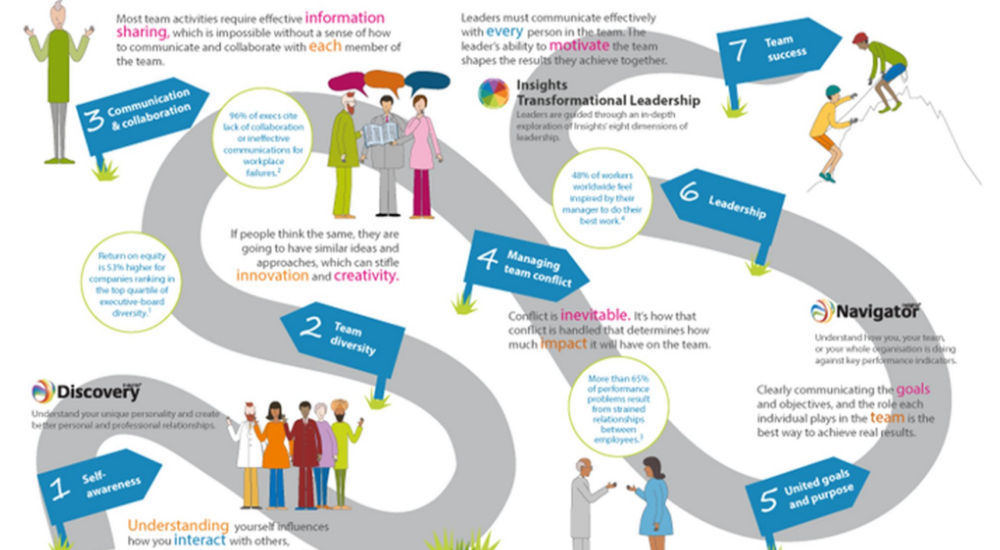
Teams exist in almost every organisation and most people will work as part of a team at some point during their working life. Teams can be defined in different ways, but in psychological terms, they are an interdependent collection of individuals working towards a common goal, who share responsibility for specific outcomes. Human beings have always existed within groups, so in many ways existing in teams is in our DNA. This would suggest that teams have a distinct advantage over operating as an individual.
The term ‘high impact team’ is becoming more frequently used in organisations and amongst consultants. It has slightly different definitions depending on who is using it, but it tends to describe teams that are highly focused and outperform in anticipated productivity. It is sometimes used to describe teams where the members also have high skill sets. However, with such a term comes the implicit recognition that not all teams are high-impact.
What is true is that most teams have the potential to have a high impact and all teams have the potential to perform better. This potential can be enhanced by knowing how to optimise team functioning which comes through an understanding of why teams do and do not function well. This white paper will explore the team within a performance and research context and lightly touch on how Insights solutions can be used to transform an underperforming team into a high-impact one.
Why Do We Operate in Teams?
“Teams are somewhat akin to audio amplifiers: Whatever passes through the device – be it signal or noise - comes out louder.” – J. Richard Hackman
The quote above is from Harvard University Professor of Psychology J. Richard Hackman. It is taken slightly out of context as it is in reference to the teams that do work. Hackman studied teams throughout his career but he openly acknowledged that many teams simply do not work. Organisations persevere with teams because of the potential that they hold. When they do work, said they can “achieve a level of synergy and agility that never could be reprogrammed by organisation planners or enforced by external managers”. Essentially, in a true high-impact team, the output is much greater than the sum of the parts.
“My model for business is the Beatles. They were four guys who kept each other’s kind of negative tendencies in check. They balanced each other and the total was greater than the sum of the parts. That’s how I see business: great things in business are never done by one person, they’re done by a team of people.” – Steve Jobs
Evidence for Team Effectiveness
There is evidence which shows that a successful working team can increase organisational performance in terms of efficiency and quality. This was the finding of a large-scale study by Applelbaum and Batt who explored 12 large-scale studies and 185 case studies. If teams are operating as they should, they have numerous advantages:
- Time is saved as tasks can be conducted concurrently rather than sequentially and are more cost-effective
- Teams can integrate and cross-reference information in a way that is beyond an individual thinker
- Innovation is increased due to the sharing of ideas
- Organisations can learn and retain learning more efficiently
What makes A High-Impact Team?
There are various ingredients involved in creating the optimum performing team and it is important to explore these in organisations in order to establish which areas are in need of improvement. The Insights Team Effectiveness Navigator can be used to identify many of the areas, and important conversations between Insights experts and organisations can uncover the rest. These issues appear at individual, group and organisational levels and in areas such as relationships, tasks, role definitions, team composition, organisational support and leadership.
“A goal properly set is halfway reached.” – Abraham Lincoln
Team Goals
The defining characteristic of a team is shared goals. As simple as this may sound, many teams do not get this right. Studies have shown that specific and clearly defined goals yield greater performance than non-specific goals. Specific and difficult goals yield the greatest results in team performance. Goals that promote individual performance within teams have been shown to have a negative effect on performance. The goals that work best are ‘group-centric’ goals which are designed to maximise each individual’s contribution to the group and have been shown to increase team performance. There is also some evidence to suggest that participative goal setting rather than assigned team goals has a positive impact on performance.
“Somebody who thinks a little differently can help to see problems as opportunities and inspire creative energy within a group. Some of the best people we’ve ever hired didn’t seem to fit in at first, but proved to be indispensable over time.” – Richard Branson
Homogeneity vs. Diversity
Teams that consist of people who are similar tend to get along well. However, this homogeneity can stifle creativity and idea generation. If people think the same then they are going to have similar ideas and approaches. There are many studies examining homogeneous vs. heterogeneous teams with varying results. Scott Page is an academic who has devoted much time to Diversity studies; he has found that heterogeneous teams consistently outperform homogeneous teams.
Educational and nationally diverse teams were found to have higher team performance than those who were not. Wiersema and Bantel examined the top management teams in 100 of the largest manufacturing companies in the US and found that diversity in educational specialisations was related to adaptiveness and change effectiveness.
Furthermore, diverse teams avoid groupthink. Groupthink is a deterioration of thinking capacity, reality testing and moral judgements within a group. It is caused by ingroup pressures for unanimity and can occur in cohesive groups. It is a trap many teams who have worked together for a long time fall into.
But diversity is complicated and although there is the potential for greater impact, there also exists a range of issues that must be managed. Jackson et al 1991, found that turnover is higher in teams who are diverse in age. This effect is at its greatest when the differences in age reflect differences in values and attitudes. Studies have also shown that ethnically diverse groups can actually perform poorly in the initial stages of group formation, although performance differences were found to level off after a period of months.
This is similar to the anecdotal evidence that Richard Branson provides in the earlier quote. His best people/ maverick thinkers did not fit in, to begin with, but after time their value became evident. Therefore, diversity can be a huge strength for a team, but conflict and cohesiveness need to be managed.
Ultimately our physical diversity, be it ethnicity, gender, disability or age, is the only indicator of diversity that is of real importance and that is the diversity of thought. If we do not have a physically diverse team then that is a surface-level indicator that we may not have diversity in thought and perspective.
Communication requires common understandings, meanings and language conventions but people from diverse backgrounds and personalities may have different understandings and norms. Insights Discovery lays the foundation of a common language through colour, which people from all kinds of backgrounds and differing personalities can easily understand. It allows these diverse groups of people to understand and communicate with each other in a global way. Understanding others allows teams to capitalise on diversity.
Team Size
There is a consistency in thought among experts that a team should not be too large. The argument for small teams is that people can interact frequently which leads to a natural flow of information. On the other hand, large teams have more resources and are more likely to operate in a more structured fashion. Research has shown that as the team size increases, the number of performance problems it encounters also increases. There is some consensus that teams should not exceed twelve.
However, Hackman advises that team size should not reach double figures and he believed the optimum team size was six. If a team inevitably has to be of a bigger size then organisations should consider making sub-units within the teams. It should also be considered whether a large team really is a team, for example, do/should members have shared goals? Team size is important in achieving optimum impact and as such it should always be considered during team formation.
Team Cohesiveness and Climate
Within any team, people tend to engage in one of two main undertakings: the maintenance of the tasks or the maintenance of the social unit. However, how much effort goes into maintaining the social unit of the team depends on ‘group cohesiveness’. Cohesiveness is the degree to which team members want to remain in the team and are committed to the team's goals.
Cohesive teams are stable, unified, satisfied and proud of the team unit. Members interact positively with each other and communicate well.
In a meta-analysis, it was discovered that cohesiveness in teams is related to successful team performance. Insights Discovery can be used to facilitate cohesiveness in un-cohesive teams or to increase cohesiveness in already functioning teams. It does this by redefining the relationships between team members by equipping them with a deeper understanding of each other. Cohesion can be developed even further with the introduction of an Insights Team Effectiveness workshop. The cohesion element lies within the climate team effectiveness pillar of the Insights Team Effectiveness model.
Another important aspect of group cohesiveness is behavioural norms. Norms regulate group processes, enforce values, allow group members to know what is acceptable behaviour and what is not, and also enable the predictableness of others' behaviour. This supports why groups can work together cohesively even when members do not like each other personally.
Many norms are implicit and are developed during the initial stages of group formation. However, value can be added by explicitly stating or noting important expected behaviours.
The climate is related to cohesiveness and in particular norms. The climate is the shared perceptions of procedures and practices and formal and informal policies.
The climate is important for the likes of job satisfaction which can impact performance.
In a study, the climate dimensions of support, respect for rules, goal-oriented information and innovation were examined in 40 teams. They found a relationship between these dimensions and job satisfaction. This shows the importance of establishing set norms as it gives teams the best chance at establishing cohesiveness and a positive climate. The Insights Team Effectiveness workshops can work to establish or realign acceptable group norms in areas such as reliability, openness, candour, and mutual respect which all fall within the climate pillar of the model.
Team Conflict
Conflict within teams often occurs and this can be interpersonal or task-related. Sometimes it depends upon the individual’s frame of reference whether they view the conflict as interpersonal or task-related. Conflict can also be defined into two other distinct categories which are constructive (functional) and destructive (dysfunctional). Constructive conflict is moderate levels of subtle or controlled opposition. Therefore reasonable people who are working in demanding conditions will be expected to encounter conflict and this can actually enhance decisions and performance. On the other hand, destructive conflict results in uncontrolled opposition destroy communication and undermine cohesiveness.
The in-group fighting becomes more important than the group goals. It is important to note that it can be a thin line between constructive and destructive conflict. There are a lot of sources of conflict, which include many of the issues we are discussing in this article such as diversity/personal factors, size, ambiguity over roles, leadership, unfair rewards, and communication. Communication is a major reason for conflict as problems in communication can result in misunderstanding due to perception issues.
It can also result in poor information exchanges. When consideration of many of these things is given, the likelihood of destructive conflict can be reduced. Communication and perspective taken can be enhanced through increased self-awareness of team members and training on adapting and connecting with others which Insights Discovery facilitates.
Task Composition
The performance of any team can be impacted by task composition issues. Task composition refers to the work that the teams are undertaking. The classification system, that has received the most support through research, is Hackman and Oldham’s 1975 Job Characteristics model.
They identified that autonomy, task variety, task significance, task identity and task feedback, are all important variables which should be high for optimum performance. This model has been shown across various industries to accurately predict team effectiveness i.e., technical, customer service, and management.
These are issues that organisations should carefully consider when allocating teamwork and going deep into the organisational structure. Sometimes it is impossible to ensure all of these measures are high as the nature of some roles and tasks may be unavoidably low in things such as variety.
However, for the likes of feedback, organisations should ensure processes are in place to make this as frequent and instantaneous as possible. Organisations should explore these issues within their teams and they can be critical conversations to have. They can also be explored with Insights experts who may point them out as challenges organisations should address before the optimum benefits of Insights interventions can be realised.
Team Composition
Team composition is about having the right mix of people within the team. This involves a mix of capabilities, skills, backgrounds, and personalities. This includes technical abilities and experience but also interpersonal skills such as communication and conflict resolution.
The risk of employing the wrong person for the job in terms of capabilities can be minimised through recruitment strategies. Insights interventions can certainly be used to facilitate development in many of these areas.
However, ability levels and experience can be a blocker to performance if the individual is not capable of performing at the level required. Selection procedures, training needs analysis and then training and coaching are all essential to ensure that staff have the skills and support required to undertake the role. In existing teams, it can sometimes be difficult to gauge whether this mix is correct or not. Insights Navigator Team Effectiveness can help identify whether the right mix of people is in the team. This is identified in the working methods element in the process pillar. Identifying these issues is important so that the foundations for the optimum performing team are laid.
Role Clarity
The clarity of the roles being undertaken is an important factor that should always be considered. Role ambiguity occurs when people do not know their role in terms of duties, responsibilities or authority. This is something that can have a detrimental effect on performance.
The balance of authority and decision-making power is a particularly important area that should be explored if an issue with role clarity is identified. This can be a major factor undermining team success. Power can be distributed throughout the team or it may lie with the team leader. Ultimately individuals need to know what level of authority they have, and the authority that others have.
Sometimes it can be the case that authority levels have not been established and no one knows. This should be addressed directly and swiftly. Insights Navigator Team Effectiveness identifies whether roles are clear or not in the working methods element of the process pillar. All of these issues can be identified, and solutions devised, during Insights Team Effectiveness workshops.
Organisational Context
The organisational context in which the team operates may impact the effectiveness of a team.
These organisational issues include the support the team receives from other teams or units within the organisation, the organisational climate and any organisational change that may impact the team or cause uncertainty amongst its members. These issues are often out of the scope of team interventions but can - and should, be explored by the organisation.
Often a major mistake of the team and the team leader, in particular, is to try and operate regardless or out of the existing organisational structures, which results in a negative impact on team performance. It is much better for teams to work within the existing organisational structure or change it throughout the organisation. It is important that team leaders and organisational leaders have the skills to lead change within the organisation when necessary and deliver results. Both of these areas are dimensions within the Insights Transformational Leadership model and can be facilitated as separate workshops or alongside the other six dimensions of Insights Transformational Leadership.
Leadership
Leadership in a team has an impact on team effectiveness. The two most widely acknowledged approaches to leadership are transactional and transformational. Transactional leaders focus on enhancements and contingent rewards and punishments, to impact upon team members' behaviours. They also manage by exception and therefore only take action when something is going wrong. Transformational leadership on the other hand involves influencing team behaviour through charisma and vision.
They are enthusiastic and stimulate new perspectives and ideas, motivating their team. They also manage at an individual level, coaching and listening to individual team members. Insights' approach to leadership is a transformational one. The Insights Transformational Leadership programme develops a leader who can motivate and show compelling visions like the typical transformational leader described in the literature, but the programme also develops the underlying qualities and skills that all transformational leaders require, such as agile thinking, and delivering results.
The Need for Team Interventions
As Hackman’s work found, healthy team development should not be taken for granted. Steiner argued that actual team productivity was more often less than its potential, due to coordination and motivation problems. The importance of taking an active approach to team development is well illustrated by Macy and Izumi who conducted a meta-analysis of 131 field studies, they found that team development interventions have a large influence on financial measures of organizational performance.
Conclusion
High-impact teams are teams that have a complex array of conditions aligned, optimizing team performance. Realistically, there are too many variables that can go wrong to take the success of any team for granted. Some high-impact teams may occur naturally although in many respects this is like the perfect storm – a rare coming together of the perfect conditions. Team and organisational interventions should not be viewed as optional. Organizations should see that team interventions are in fact essential or teams may be better off working as individuals. Insights can provide a research lead solution package to create these optimum conditions and encourage the business to examine or address areas that may be blockers to high impact. With over twenty years of solution experience, Raiser Resource Group can be trusted to nurture every team to optimum performance.





